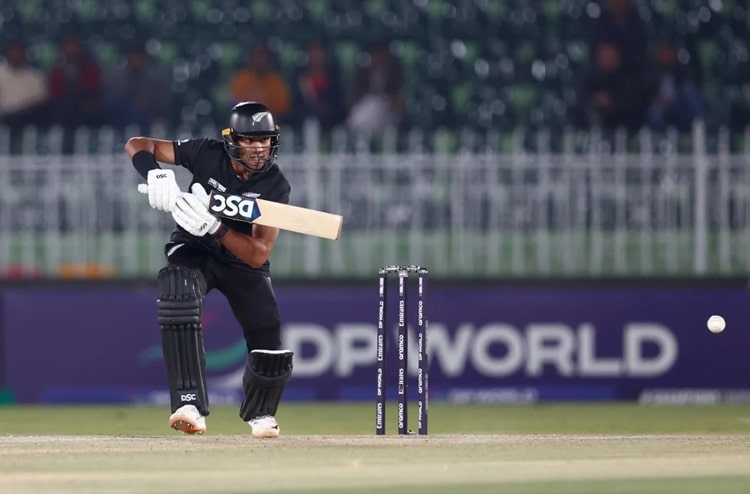Watch cricket video highlights of Champion’s Trophy 2025 sixth Match 2025. Between New Zeaaland and Bangladesh. Venue of the match will be Rawalpindi.
Copyright – Third Party Reference Inline Linking Embedded Video from ICC
Report
Numerous teams are experiencing transitions right now, yet throughout this Champions Trophy, New Zealand has demonstrated that their emerging talents are prepared for the big stage. It wasn’t too long ago that Kane Williamson bore the weight of this batting lineup. Now, it appears that Rachin Ravindra is ready to assume that responsibility. He didn’t hesitate to step into an unfamiliar role. He remained unfazed coming in at 15 for 2.
He kept smiling when he reached his century, an innings that not only secured his team’s place in the semi-finals but also ensured India’s advancement. Pakistan and Bangladesh have now officially been eliminated. This was a must-win match for Najmul Hossain Shanto’s side to keep their hopes alive. However, they batted as if the task was far too daunting. Bangladesh began at nearly a run a ball but then saw 10 of the next 15 overs yield three runs or fewer. The pressure created in this phase led to the downfall of Mushfiqur Rahim and Mahmudullah.
Despite having a combined experience of 511 matches, they could only muster 6 runs in a crucial game. Their dismissals left Shanto with limited options. He continuously had to adapt to new partners and evolving match situations, ultimately resulting in a disjointed innings of 77 off 110. He could have performed better. The rest could have stepped up as well. Taskin Ahmed and Nahid Rana sparked Bangladesh’s hopes with a electrifying opening spell, knocking over Will Young’s stumps in the first over and dismissing Williamson for an unusually low single-digit score.
The infield was densely populated at this moment. The atmosphere was electric, with the crowd contributing to the excitement. Ravindra then came to the crease. One of the standout aspects of his batting is his finesse. It’s remarkably refined. Batting at No. 4 – he was included in the XI to replace an unwell Daryl Mitchell – there was some risk that he may not fully capitalize on that opportunity. Yet, by chance, he started his innings during the field restrictions, allowing him to take advantage of his timing.
His first five boundaries were all about exploiting the gaps, with his timing ensuring the rest. Ravindra had to wait 11 overs after the field spread to find his next boundary, but he wasn’t stagnant during that time. His initial 23 runs came off 21 balls, featuring five fours. He then scored 28 runs off 29 balls with just one four. There was one moment that could have turned disastrous; a misunderstanding with his Wellington teammate Devon Conway might have led to a run-out had Tanzid Hasan managed to make a direct hit in the 12th over.
Bangladesh failed to capitalize on their opportunities. New Zealand seized theirs. Williamson contributed significantly by taking smart catches at short midwicket and cover. Michael Bracewell, after a flawless 10-over spell, dashed 30 yards to his right to make a diving catch, which he probably didn’t have to take but chose to go for it, and it paid off. Bangladesh also struggled to rotate the strike. New Zealand excelled at it. Those aspects were the main differences between the two sides.
The pitch became considerably more favorable for batting under the lights, a factor that Mitchell Santner anticipated when he won the toss and opted to chase; with Bracewell turning out to be his secret weapon with the ball. The 34-year-old off-spin bowling allrounder himself was surprised to claim 4 for 26 from 10 uninterrupted overs. In a mid-innings interview, he stated, “It’s a funny one; once you release [the ball], you don’t have much control over what happens at the other end. “Bracewell played a key role by delivering 43 of the 178 dot balls that hindered Bangladesh’s innings.
You would have to look back to 2012 to find a performance where they struggled with their pace as much. Rotating the strike proved difficult, and the methods they chose to escape from that situation were not the best. It’s possible that the pitch was too sluggish in the afternoon to effectively find gaps to exploit. Mushfiqur attempted a shot against Bracewell but failed to clear the long boundary with his slog sweep. Bangladesh found themselves at 106 for 4 in the 23rd over.
At a time when they really needed to build some stability, Mahmudullah made a poor decision to come down the pitch and ended up hitting a leading edge to cover. Bracewell’s effectiveness came from deliberately reducing his speed. Bangladesh’s own errors were far more significant. They left the tournament having faced over 50 overs without scoring. Their decision-making was so lacking in resources that they had Taskin facing the 45th over, which resulted in a maiden over. The final overs were a complete show of strength for the Black Caps.
At one stage, they comfortably fielded with just three players on the boundary, instead of the five permitted. Towards the end of the chase, Bangladesh was reminded of what might have been when they saw sharp turn, leading edges, inconsistent bounce, and even a direct-hit run-out. The wicket added to their frustration about the missed opportunity – Ravindra was on 25 when Tanzid’s miscue occurred – as well as the runs that slipped away; reaching 260 would have made the match much more competitive.
In reality, New Zealand approached the chase knowing that all they needed were a couple of partnerships, which they successfully achieved. Ravindra shared a 57-run stand with Conway and then a 129-run partnership with Tom Latham, who excels at managing crises. One could easily envision him as the reliable partner to whomever is leading the last remnants of humanity during a zombie apocalypse. But for now, there’s an ICC trophy on the line.
